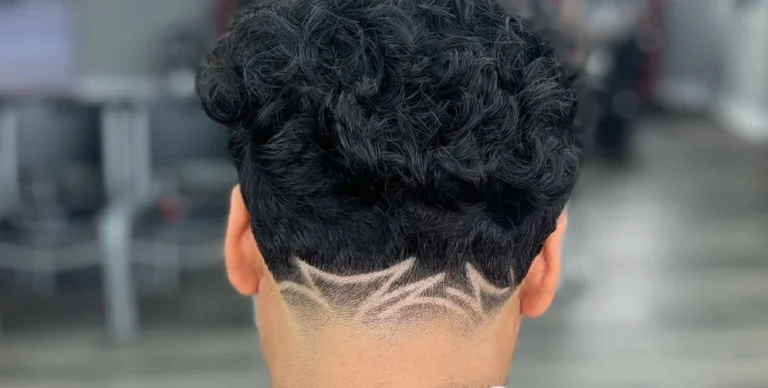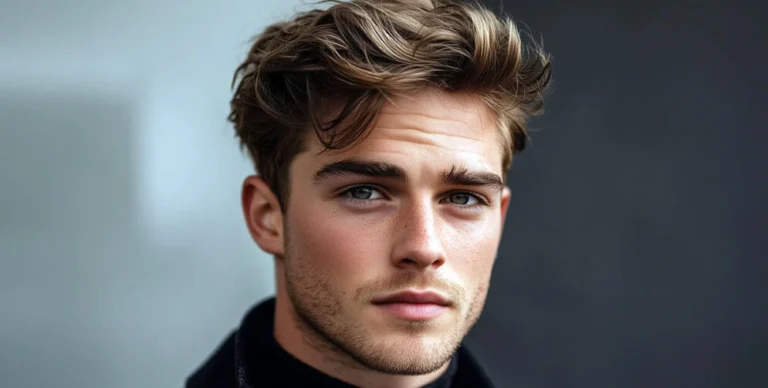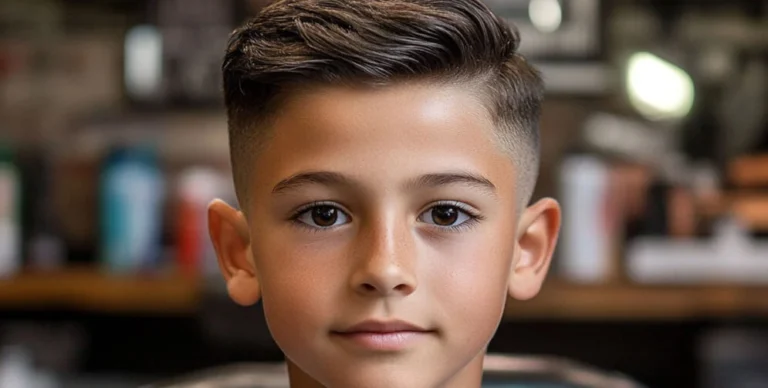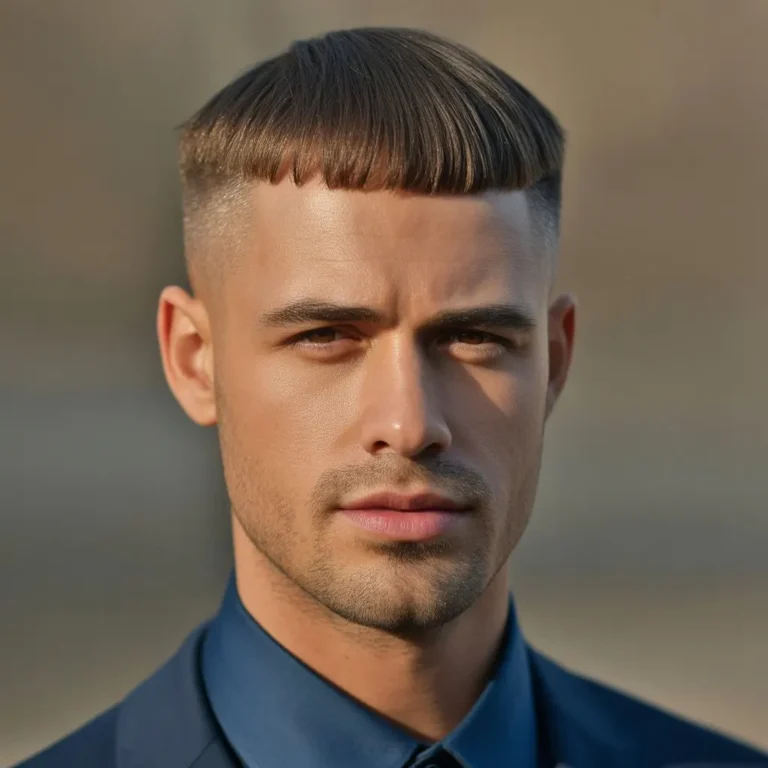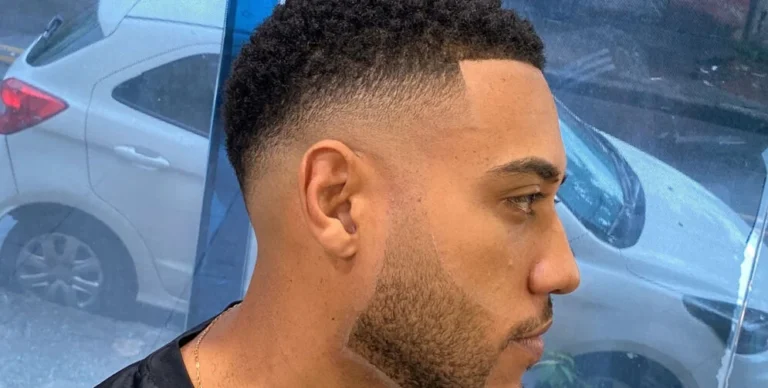The Ultimate Guide to Undercut Hairstyles (2025 Edition)

The first time I asked my barber for a disconnected undercut, I remember every detail. The buzzing of the clippers filled the shop, drowning out the chatter about last night’s football match. The smell of hair product mixed with talc powder hung in the air. As the machine traced a sharp line above my ear, I caught my reflection in the mirror — halfway between doubt and anticipation.
Why? Because in 2025, the undercut isn’t just a haircut. It’s one of the top five most-requested styles globally, worn by everyone from Kylian Mbappé on the pitch to TikTok creators racking up millions of views with slick back transformations. Get it right, and you project sharpness, confidence, and control. Get it wrong, and you’ll wonder if you’ve made a mistake that will take six awkward months to grow out.
So here’s the real question: does the undercut suit your face, lifestyle, and career? Is a low taper fade undercut more manageable for students than a Viking-inspired shave? And is the extra 2–3 barber visits per month (costing $30–$100 each) worth the style payoff?
This guide will break down every variation, cost, and secret your barber won’t tell you.
What Is an Undercut Hairstyle?
An undercut is a hairstyle where the sides and back are clipped short or shaved while the top is left noticeably longer. This sharp contrast creates a bold, modern look that can be styled in many ways — slick back, textured quiff, pompadour, or even a skin fade undercut. The style dates back to early 1900s Europe, but has re-emerged as a modern classic in 2025.
I still remember a friend leaving the barber’s chair, catching his reflection, and instantly smiling at how defined his jawline looked. That’s the power of the undercut hairstyle meaning — it transforms not just hair, but confidence. Ever wondered why this sharp contrast instantly makes the face look more structured?
Undercut Meaning Explained
The undercut hairstyle meaning is simple: the sides and back are cut very short or shaved while the top remains noticeably longer. Unlike a fade, which blends smoothly, the undercut creates a disconnected look — sharp contrast that instantly catches the eye.
Barbers call it a “style of separation.” Sit in the chair and you’ll feel the clippers buzzing near the scalp while the top is left untouched — the defining moment of an undercut haircut.
One client once told his barber: “It’s not just my hair, it makes my jaw look sharper.” That explains why surveys rank it among the top five men’s cuts in 2025. Ever wondered why contrast feels so powerful? Because it makes faces look stronger, leaner, and more confident.
What Is the Difference Between an Undercut and a Fade?
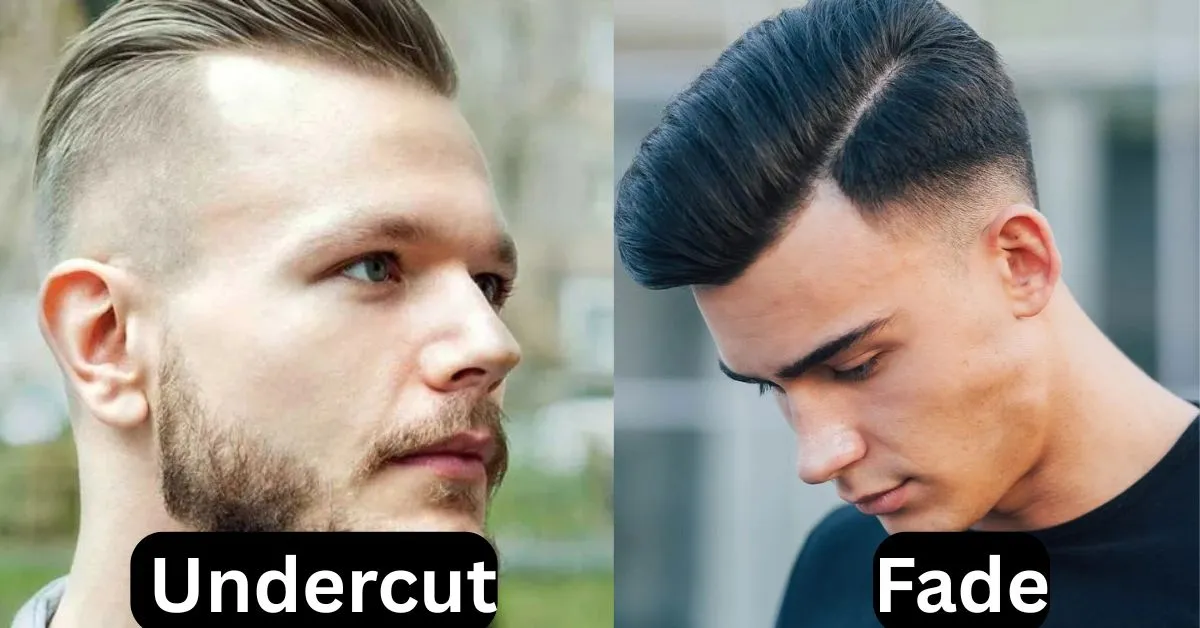
The key difference between an undercut vs fade lies in transition. In an undercut haircut, the sides are clipped short or shaved evenly, often with no guard or a #1, leaving a sharp disconnect from the longer top. In a fade, barbers taper gradually using guards like #0 to #2, blending smoothly into the top length.
I once watched a barber line up two brothers: one with a slick back undercut that made his cheekbones pop, and the other with a low skin fade that gave a softer, more natural look. Both walked out confident, but in very different ways.
So here’s the real question: which would actually flatter your face more — bold disconnect or smooth blend?
Origins of the Undercut (History & Evolution)
The history of the undercut hairstyle dates back to early 1900s Europe, when working-class men in Germany and the UK chose it for practicality — barbers shaved the sides quickly, leaving the top long. By the 1920s–30s, the US gangster era embraced it during Prohibition, linking the cut with jazz clubs and mob culture.
In Asia, the style resurfaced later through K-pop and street fashion, shaping the sleek modern undercut origin we see today. Beckham revived it in the 2010s, while TikTok stars and footballers made it a global trend in 2025. So, is the undercut simply history repeating itself — or the future of men’s style?
Popular Undercut Styles & Variations
The beauty of the undercut hairstyle lies in its versatility. It’s not just one look — it adapts. I once saw two friends walk out of the same barber shop, both asking for an undercut, yet one looked sharp and business-ready while the other had a rebellious street-style vibe. That’s the magic: the same foundation, but endless expressions.
Barbers often say, “An undercut is like a suit — it has to be tailored to the man.” In this section, we’ll break down the most popular undercut haircut variations — from the classic undercut to bold styles like the disconnected or slick back. So, which undercut variation will match your personality?
Classic Undercut

The classic undercut hairstyle is where it all began. Short sides and back are clipped evenly, while the top is left noticeably longer, creating that sharp contrast. Think of it as the original blueprint that modern variations evolved from.
Barbers usually keep the sides between a #1–#3 guard, leaving enough length on top (3–5 inches) for styling. You can slick it back with pomade for a polished office look or leave it textured for a casual vibe.The classic undercut works best on oval or square faces, since the sharp contrast defines angles naturally. For round faces, leaving extra volume on top balances proportions. I remember a client in 2022 who walked in tired of his shapeless cut — after a classic undercut, he said, “It feels like my jawline just appeared.”
Disconnected Undercut
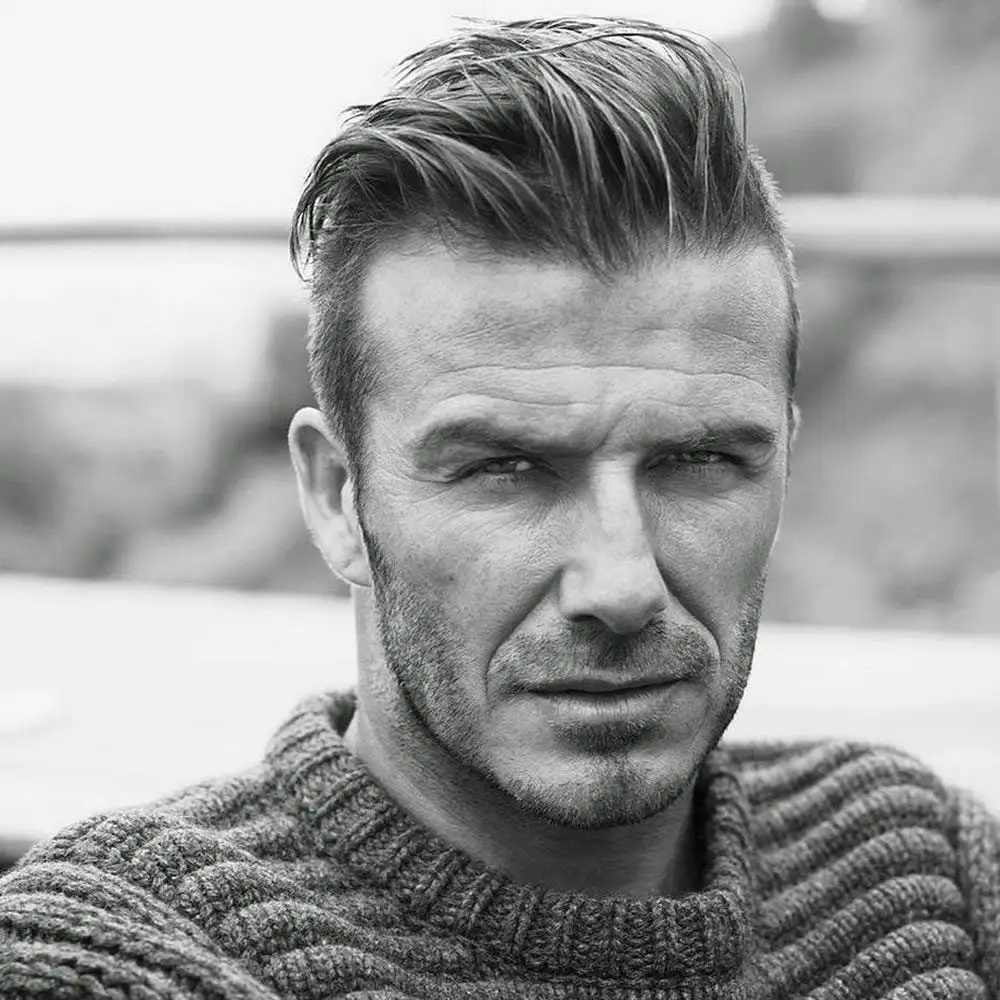
The disconnected undercut hairstyle is all about contrast. Unlike the classic version that blends slightly, this style creates a bold separation — the sides are clipped very short (often #0–#1 guard), while the top remains long and untouched. The result? A dramatic “step” effect that instantly grabs attention.
This undercut works best on oval and diamond-shaped faces, since the disconnect emphasizes structure. For round faces, it can appear too harsh unless balanced with extra height or a beard.
I once watched a barber style two clients back-to-back: one left with a slick, businesslike side-part disconnected cut, while the other styled his into a messy quiff. Same haircut design , totally different vibe — proving how versatile yet edgy this variation is.
So, are you bold enough to rock the disconnected undercut?
Tapered Undercut
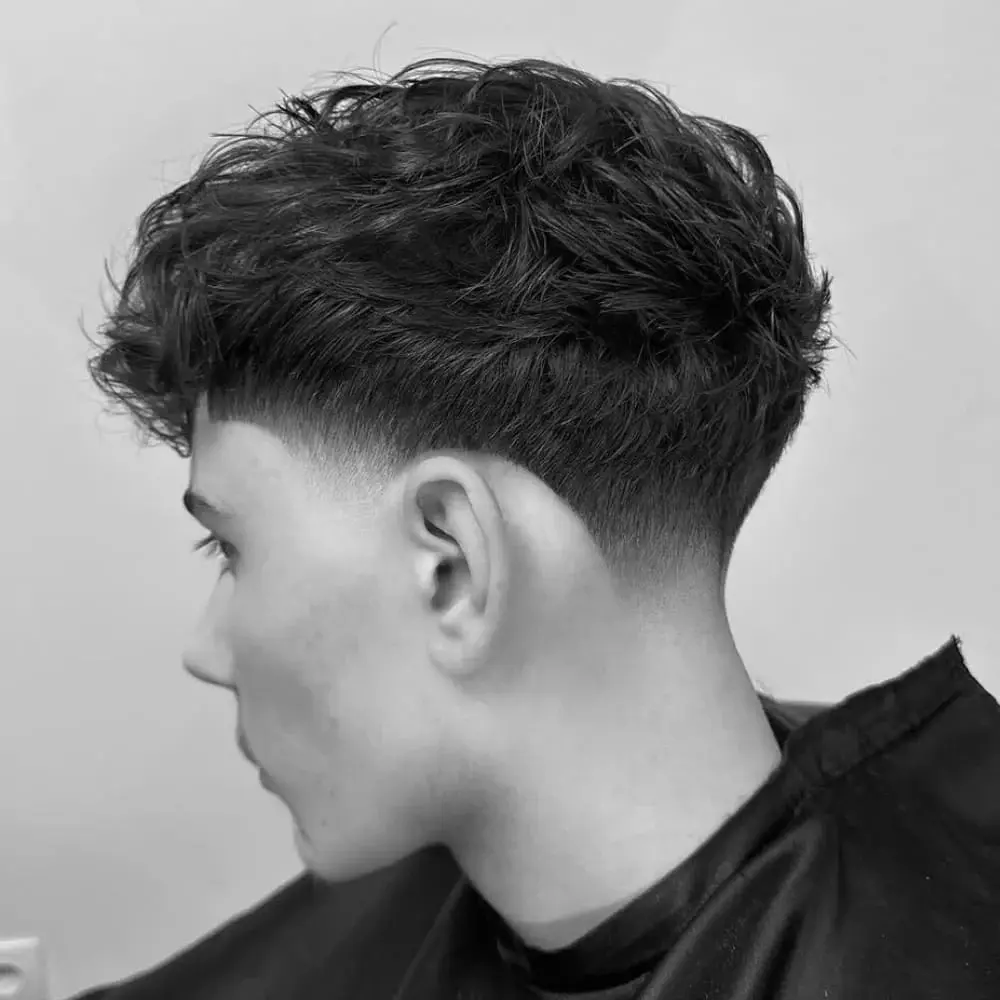
The tapered undercut is the middle ground between a sharp disconnect and a smooth fade. Instead of clipping the sides at one uniform length, the barber gradually tapers them shorter as they move toward the neckline. The top, however, stays long enough (3–6 inches) for versatile styling.
This variation works especially well for round and heart-shaped faces, since the tapering creates a slimming effect on the sides. On square faces, it softens the jawline without losing masculinity. Barbers usually use guard sizes from #3 down to #1 for the taper, giving a cleaner transition. One of my friends switched from a disconnected to a tapered undercut before job interviews — he told me, “It feels professional but still stylish.” That’s exactly why this cut bridges casual and corporate worlds perfectly.
Undercut Fade
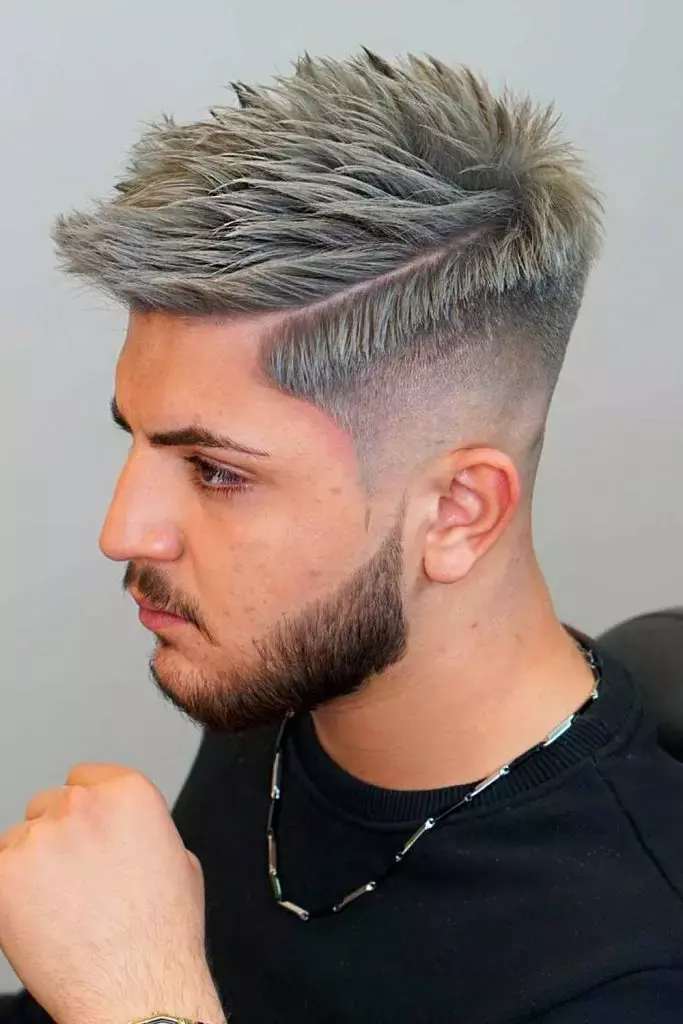
The undercut fade blends the sharp contrast of an undercut with the smooth graduation of a fade. Instead of a harsh line, clippers (usually guards #0–#2) taper the sides while leaving volume on top. It’s versatile, trendy, and easier to maintain than a disconnected cut. Let’s break it down into three key styles:
Low Fade Undercut
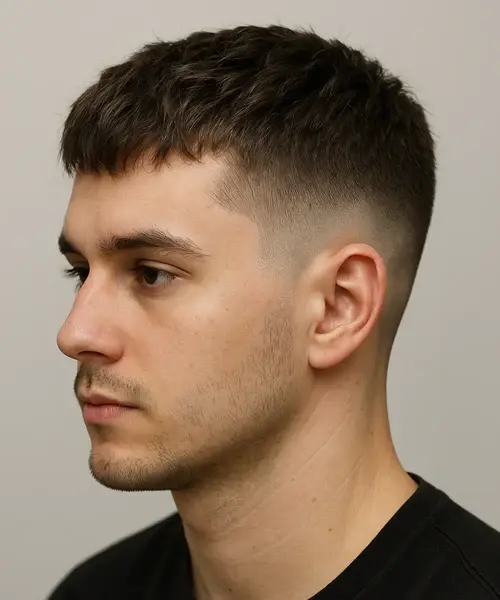
The low fade undercut starts just above the ear and follows the natural hairline. Barbers often use a #0 or #1 guard at the base, gradually blending upward. It works best for round and oval faces, giving a professional and understated look — perfect if you want style that won’t get side-eyes at work.
Mid Fade Undercut
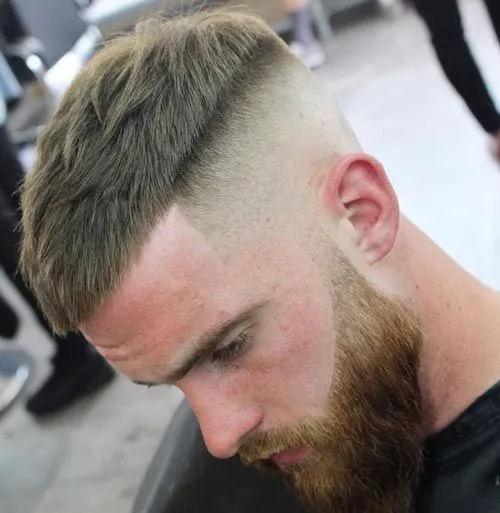
The mid fade undercut begins around the temples, usually blending from a #1 guard up to #3 or #4. It adds definition and balance to most face shapes. I once saw two friends walk into a barbershop asking for the same mid fade — one paired it with a textured quiff, the other slicked it back. Same cut, but their personalities completely changed the vibe. That’s the power of this versatile style.
High Fade Undercut
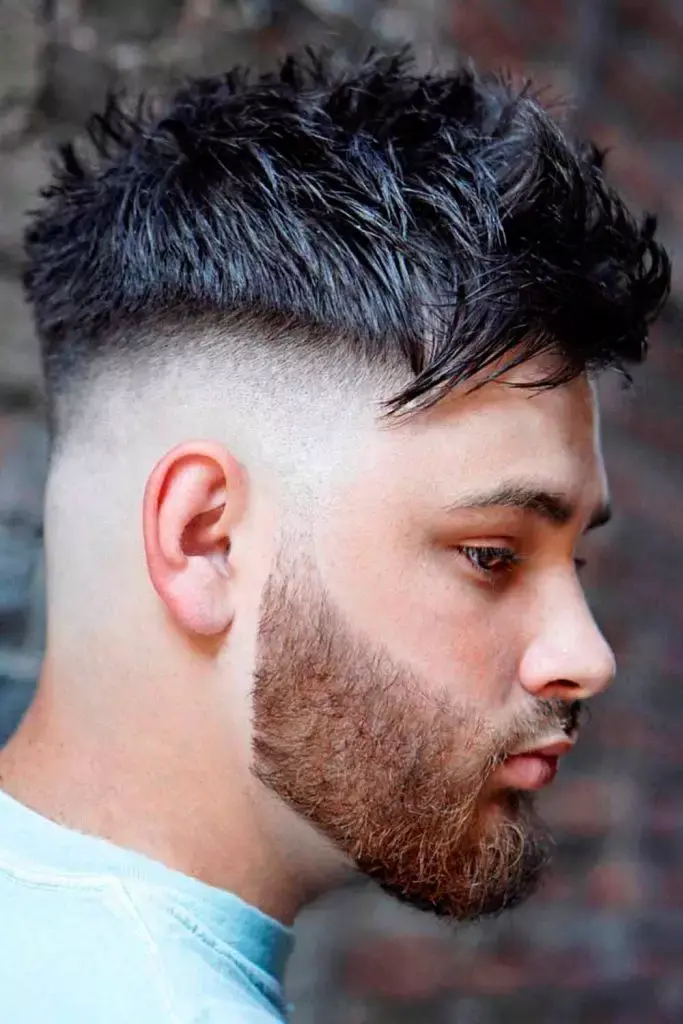
The high fade undercut rises sharply above the temples, often starting with a skin fade (#0) and blending into longer lengths. It’s bold and dramatic, flattering square or diamond-shaped faces that carry strong angles. Paired with a beard or stubble, it’s the go-to choice for men chasing that streetwear-inspired edge.
Ever wondered which fade would sharpen your features the most — low for subtlety, mid for balance, or high for boldness? The right choice can completely transform how your face looks.
Side Part & Hard Part Undercut
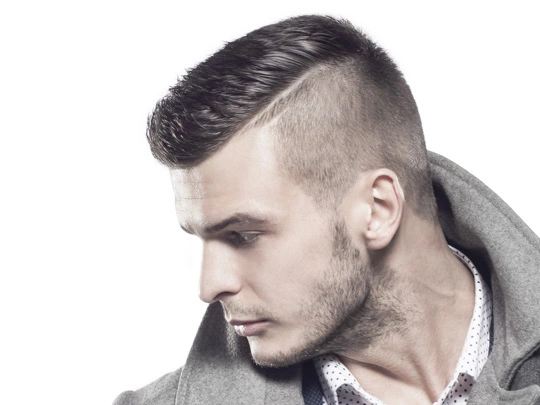
The side part undercut combines a traditional gentleman’s side part with the edgy contrast of an undercut. A hard part is when the barber shaves a clean line with a trimmer or razor to exaggerate the separation.
Barbers usually set the sides with #0 to #2 guards, while leaving 3–5 inches on top for styling flexibility. The razor-sharp hard part acts like a permanent comb line, making styling easier but also requiring regular upkeep.
Face Shapes
- Oval & Square faces: Look best, since the defined part highlights symmetry.
- Round faces: Benefit from added height on top, balancing proportions.
Pair the side part with pomade or matte clay for slick, business-ready vibes, or with textured wax for a more casual, modern finish. Great for office, weddings, and formal events.
One of my clients once got a side part undercut for his job interview. He walked in looking like a banker, but the crisp hard part gave him just enough edge — he swore it boosted his confidence before walking into the panel.
Would you dare to carry a razor line that announces style before you even speak?
Slick Back Undercut
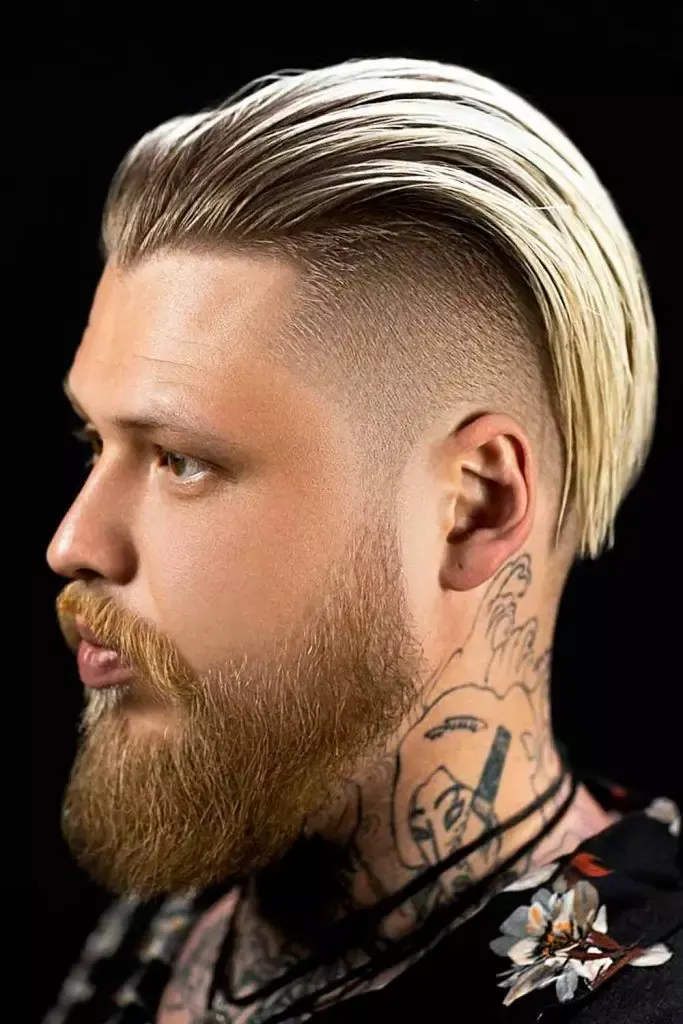
The slick back undercut is one of the most iconic versions of the cut, made famous by TV shows like Peaky Blinders. It combines short, buzzed sides with longer hair on top that’s combed straight back for a polished, vintage look.
Barbers typically use #0–#2 guards for the sides and leave 4–6 inches on top. A blow-dryer plus a strong-hold pomade or gel is key for achieving that glossy, controlled finish.
Face Shapes
- Oval & Square faces: Ideal, as the slicked-back top emphasizes sharpness.
- Round faces: Should keep extra height for elongation.
- Heart-shaped faces: Balanced by a slightly looser slick rather than ultra-tight.
This cut thrives in formal settings — boardrooms, black-tie events, or weddings. But it can just as easily be modernized with matte clay for a softer, casual vibe.
I once tried the slick back undercut before a cousin’s wedding. With the tuxedo and polished shoes, the hairstyle completed the look — my own family didn’t recognize me at first glance.
The real question is — are you ready for a hairstyle that can transform you from everyday casual to vintage gentleman in seconds?
Pompadour Undercut
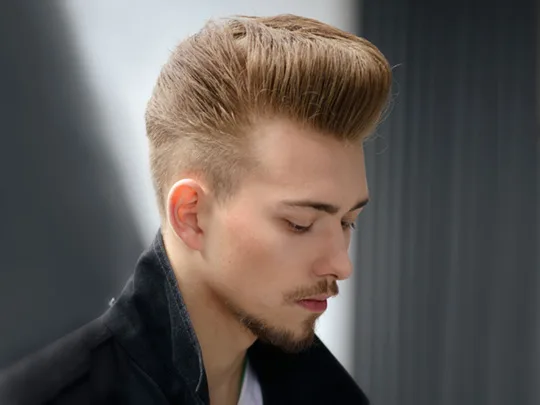
The pompadour undercut takes the timeless Elvis-inspired pompadour and modernizes it with sharp, buzzed sides. The result? Height, volume, and contrast that instantly draws attention (warning: may cause neck turns in public 😏).
Sides are trimmed with #0–#2 guards, while the top is left 5–7 inches long. A round brush, blow-dryer, and volumizing mousse or strong-hold pomade are essentials to achieve the lifted wave. For a more relaxed vibe, a matte clay or lightweight cream works well without the glossy finish. Some barbers even taper the nape slightly for cleaner balance.
Face Shapes
- Round faces: Perfect match, since the added height elongates the face.
- Oval faces: Naturally suited, as the pompadour emphasizes balance.
- Square faces: Works well if styled with softer edges to avoid too much angularity.
This style thrives in fashion-forward events, nightlife, or creative industries where making a statement matters. It’s less corporate, more “trendsetter.”
A friend of mine rocked a pompadour undercut to a music festival last year. With sunglasses and a denim jacket, he looked like he had walked out of a 1950s magazine cover — and yes, strangers actually asked him for pictures.
So, is the pompadour undercut just retro revival — or the boldest way to own 2025 style?
Messy Undercut
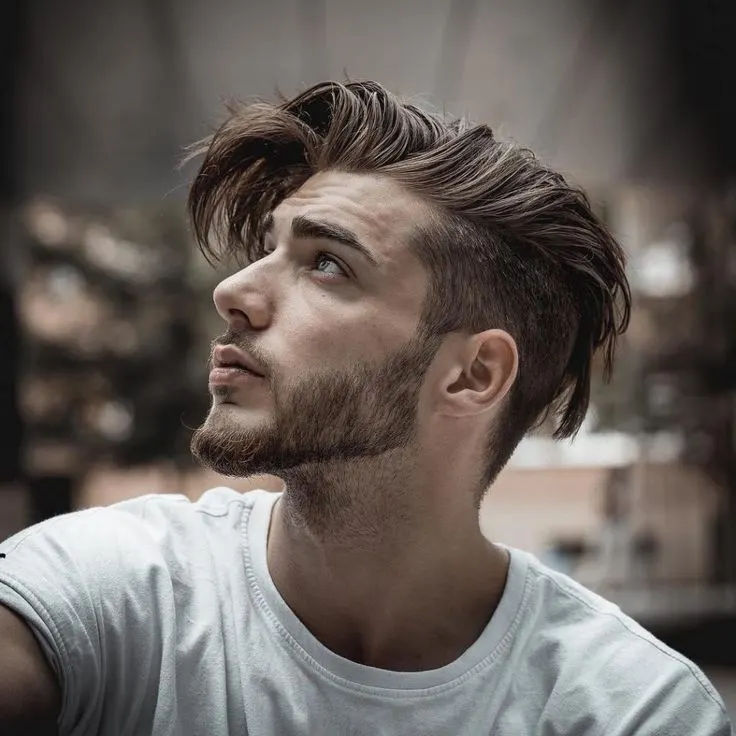
The quiff undercut is like the pompadour’s laid-back cousin — more casual, slightly tousled, and easier to pull off daily. The messy undercut variation adds texture and freedom, making it look effortless yet stylish.
Barbers usually trim sides with #0–#2 guards, leaving 3–5 inches on top. A blow-dryer plus matte clay or texturizing powder is ideal to create natural lift without stiffness. The messy variation works best when hair has a bit of wave or natural volume.
Face Shapes
- Round faces: Benefit from added height and messy texture that elongates.
- Oval faces: Pull it off effortlessly.
- Heart-shaped faces: The loose texture balances a wider forehead.
Perfect for college students, casual office spaces, and creative professionals. Unlike slick styles, the quiff undercut feels modern, approachable, and versatile — whether for brunch or a night out.
I once saw two friends leave the barber with quiff undercuts. One styled it polished with a brush, the other just ran his fingers through — yet both looked equally confident. That’s the magic of this cut.
After all, isn’t the messy undercut proof that sometimes imperfection is the real style statement?
Viking undercut
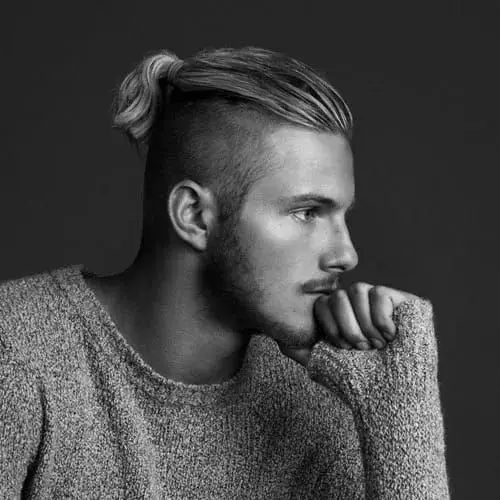
The Viking undercut (also called the Nordic warrior haircut) channels warrior-inspired aesthetics — shaved or tightly clipped sides with long hair on top, often tied into braids, ponytails, or a man bun. It’s bold, primal, and instantly makes a statement, making it one of the most searched Viking hairstyle men trends in 2025.
Sides are usually clipped with #0–#1 guard or even completely shaved for maximum contrast. The top is left 8–12 inches (or more) to allow braiding, knotting, or free-flow styling. Popular versions include the braided undercut style paired with a beard for the complete Viking aesthetic.
Face Shapes
- Square & Oval faces: Best suited, as the strong jaw complements the warrior vibe.
- Round faces: Can work if the top is styled higher for elongation.
Perfect for festival-goers, gym enthusiasts, or men who love bold aesthetics. This style thrives in casual or creative settings — but may feel too aggressive for formal corporate roles.
At a cosplay event, I met a guy with a Viking undercut and a braided beard. People literally lined up to take pictures with him — the haircut wasn’t just a style, it became a character.
So the question is — do you want a haircut that blends in, or one that makes you look like you’ve stepped straight out of Valhalla?
Undercut with Beard
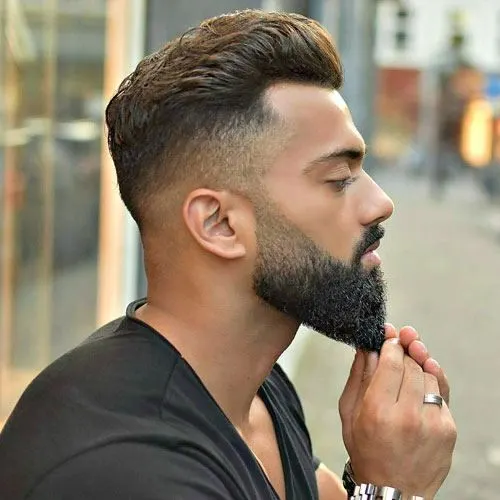
The undercut with beard is the ultimate masculine combo — sharp, clipped sides paired with a full or trimmed beard for balance. This contrast highlights facial structure, making it a go-to style for men who want both edge and maturity.
Barbers usually use #0–#2 guards for the sides, blending cleanly into longer top hair (3–6 inches). The beard can be kept short boxed, faded, or full Viking-style depending on preference. Many barbers now offer beard fade + undercut packages, creating seamless transitions from scalp to jawline.
Face Shapes
- Round faces: A beard elongates the chin while the undercut adds height.
- Square faces: A fuller beard softens strong angles.
- Oval faces: Almost every beard-undercut pairing works well.
Ideal for modern professionals, grooms, or style-conscious men who want versatility. Works great in casual to formal setups, since the beard tones down the aggressiveness of the undercut.
A barber once told me, “An undercut without a beard makes you look stylish — but add a beard, and suddenly you look powerful.” I saw it firsthand when a colleague grew a beard with his undercut; overnight, people said he looked more confident and authoritative.
After all, isn’t the real flex in 2025 not just having an undercut — but pairing it with the perfect beard style?
Undercut by Hair Length
Short Hair Undercut
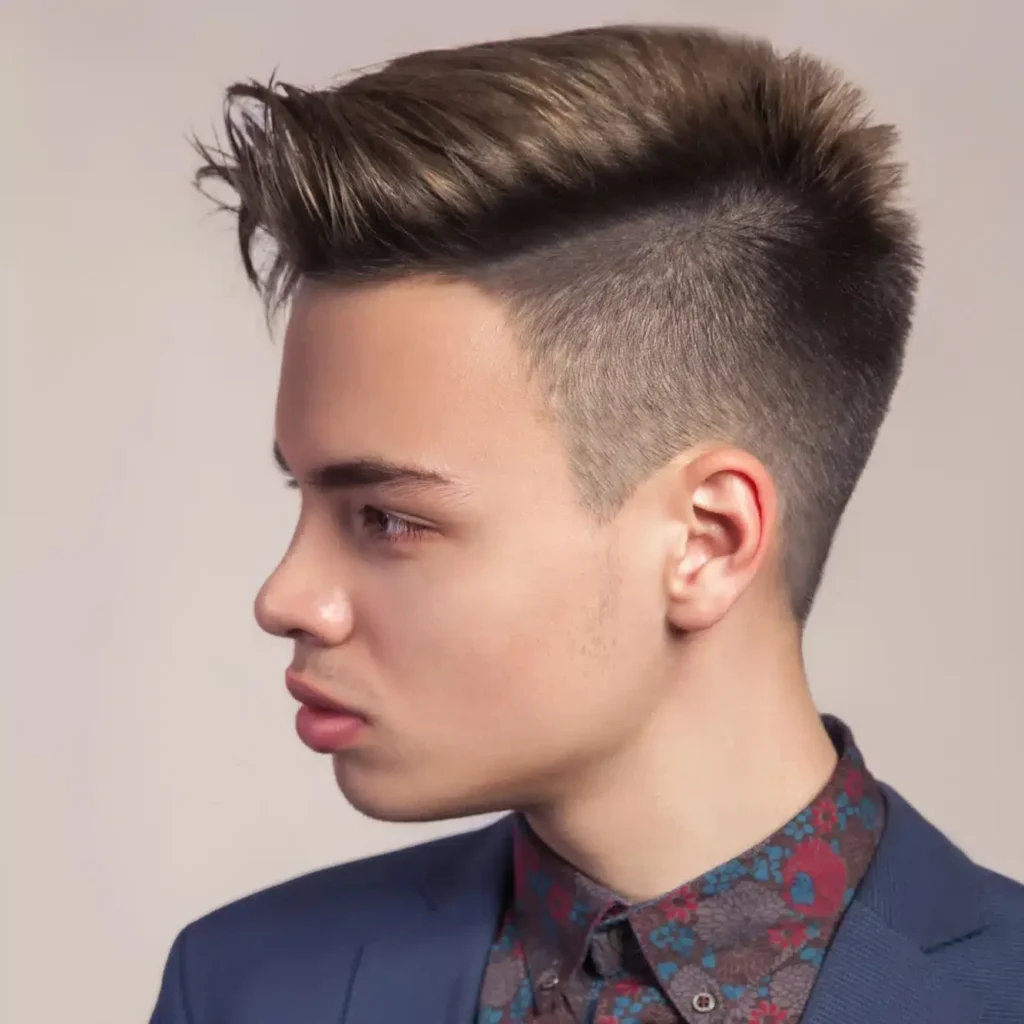
The short hair undercut is the most low-maintenance version of the style — clipped sides with just 1–3 inches left on top. It’s clean, sharp, and easy to style daily.
Barbers often use #0–#2 guards on the sides, keeping the top short enough to style with a little matte clay or light gel. It takes less than 10 minutes to set in the morning.
Face Shapes
- Round & Oval faces: Short tops help sharpen features.
- Square faces: Works well if a bit of texture is added on top.
Perfect for students, athletes, military men, or anyone with a busy schedule. It’s also sweat-proof and gym-friendly — you don’t need a blow-dryer or fancy products.
One of my cousins got a short undercut before joining university. He said it saved him time every morning, yet still got him compliments from classmates who thought he’d “leveled up” his style.
Sometimes, the shortest cuts make the longest impressions — could the short undercut be your easiest style upgrade?
Medium Hair Undercut
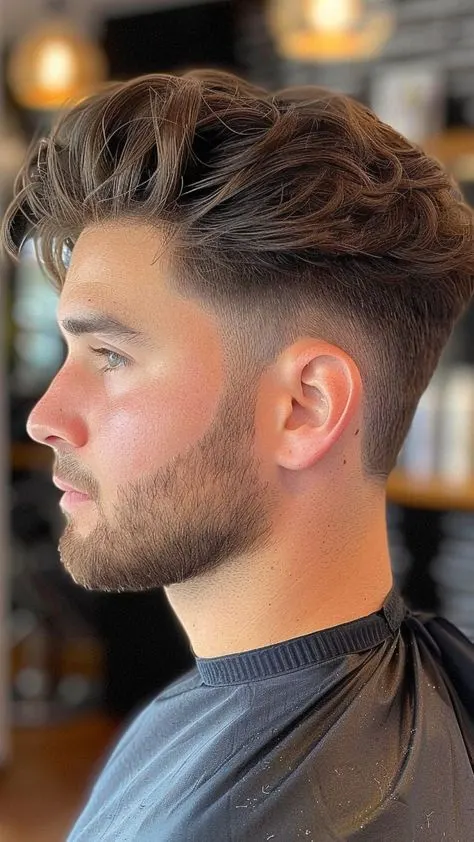
The medium hair undercut strikes the balance between sharp and versatile. With 3–5 inches left on top, you can style it slick, textured, or swept — without it being too high-maintenance.
Sides are trimmed with #0–#2 guards, while the top length allows for multiple finishes. Products like matte clay, sea-salt spray, or medium-hold pomade are ideal for keeping flexibility without stiffness.
Face Shapes
- Oval faces: The most adaptable, works with nearly any styling choice.
- Round faces: Benefit from extra height and volume on top.
- Square faces: Textured tops soften sharper angles.
Great for office workers, creatives, and social outings. The medium length can be styled professional for weekdays and loosened for weekends.
I once saw two clients leave the same barber shop with medium undercuts — one styled his into a slick side part for a corporate event, while the other left it messy and casual for a café meetup. Same cut, totally different vibes.
Isn’t the beauty of the medium undercut that it adapts as quickly as your lifestyle does?
Long Hair Undercut
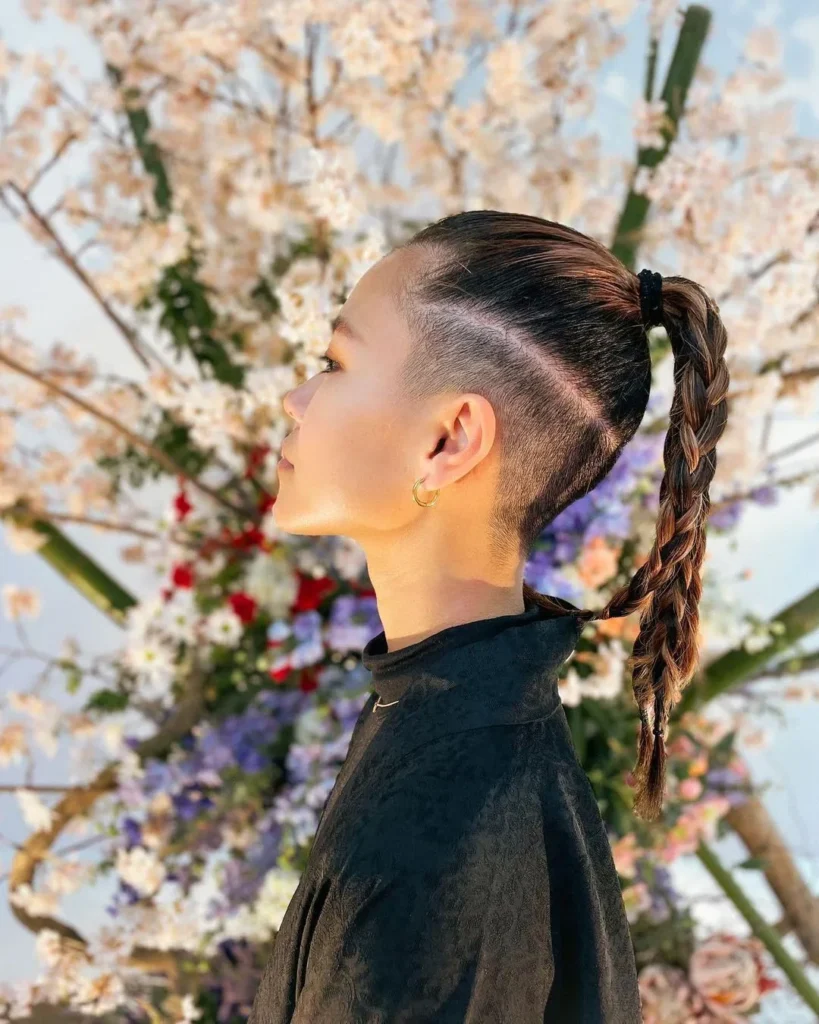
The long hair undercut combines dramatic contrast — buzzed sides with 6–10+ inches on top. It’s bold, eye-catching, and allows creative styles like slick-backs, braids, or even man buns.
Barbers clip the sides with #0–#2 guards, while the top is left long enough for styling experiments. To manage volume, products like leave-in conditioner, lightweight mousse, or styling cream are must-haves. Blow-drying with a round brush helps control flow.
Face Shapes
- Oval & Diamond faces: Best suited, since the long top highlights symmetry.
- Round faces: Can pull it off if styled high to elongate features.
- Square faces: Pairing with softer styling balances angles.
This cut thrives in fashion shoots, nightlife, concerts, or creative industries. It’s less about blending in and more about standing out.
At a wedding, one guest rocked a long undercut tied into a sleek bun. People whispered he looked like a mix between a model and a rockstar — proof that the long undercut doesn’t just style hair, it creates presence.
The real question is — are you ready for a hairstyle that gets noticed before you even say a word?
Man Bun Undercut
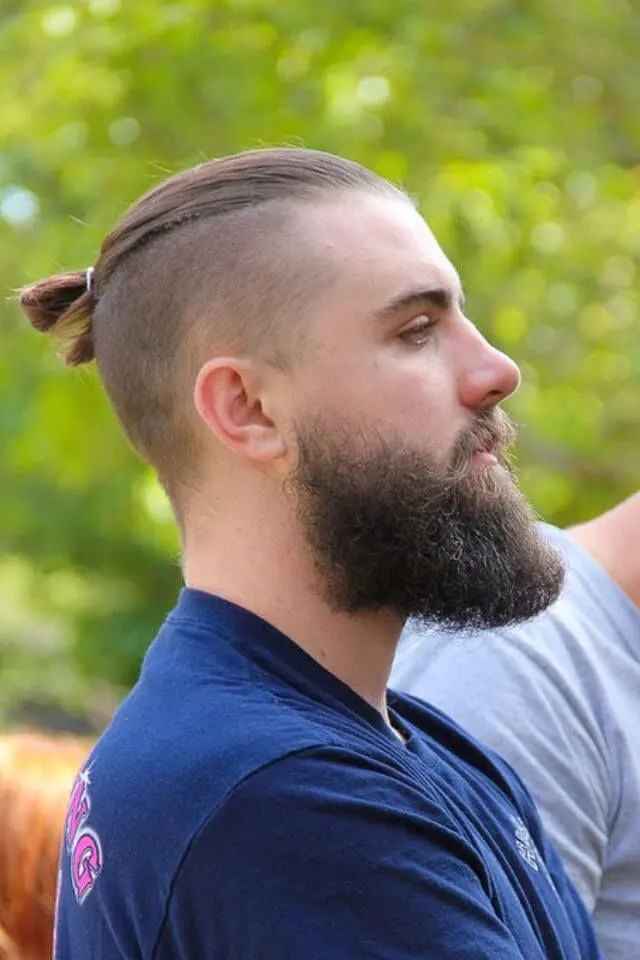
The man bun undercut is where the buzzed sides meet a tied-up top, usually 6–12 inches long. It blends practicality with a sharp, warrior-inspired aesthetic.
Barbers typically clip sides with a #0–#1 guard, keeping the crown long enough to tie into a bun. A fade can be added for a smoother transition. Elastic bands should be snag-free to avoid hair breakage.
Face Shapes
- Oval/Diamond faces: Ideal — balances symmetry.
- Round faces: Works if bun is styled higher to elongate the profile.
- Square faces: Looks best with slightly looser, textured buns.
This look thrives in urban fashion, fitness culture, and creative workplaces. It’s often linked with confidence and individuality.
I once trained with a client at the gym who wore a man bun undercut. Every time he finished a set, someone would compliment his look. He laughed and said, “This cut does half the socializing for me.”
Could a simple bun really turn into your most powerful style statement? With the undercut, it just might.
Mullet Undercut
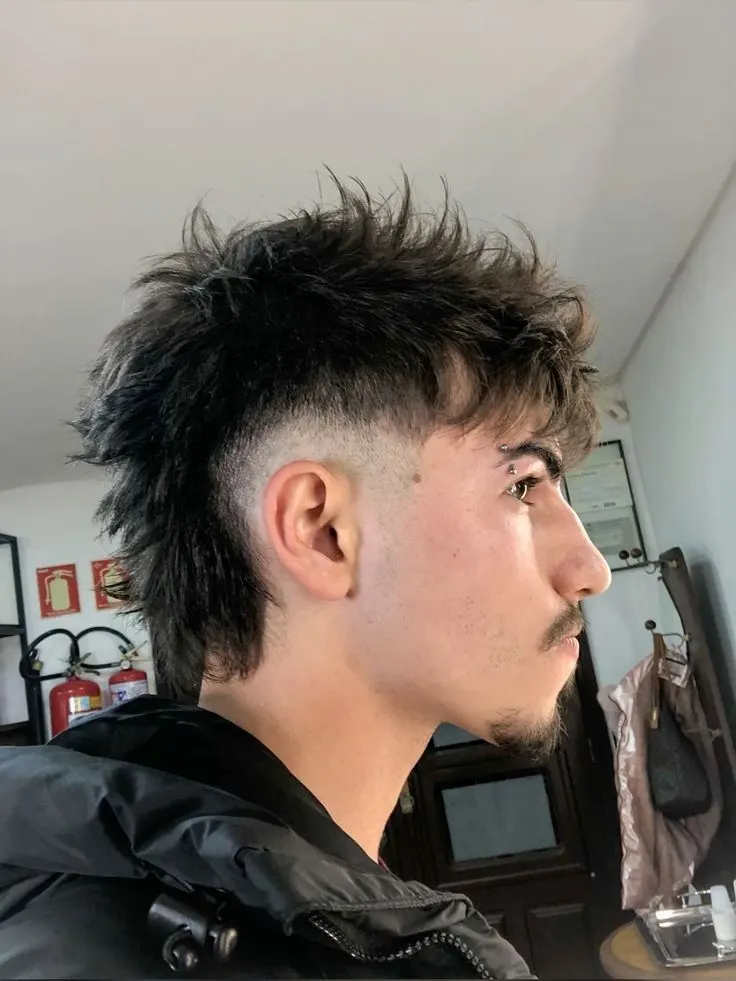
The mullet ponytail undercut is where tradition meets rebellion: short, faded sides, long back, and a tied ponytail for flair. It’s like the revival of the retro mullet — but sharper and cleaner in 2025.
Sides are clipped with #0–#2 guards, while the back is grown 8–12+ inches for tying. Some barbers taper the nape for smoother flow. Styling needs light pomade or hair serum to avoid frizz.
Face Shapes
- Oval/Diamond: Pulls off best — showcases symmetry.
- Round: Works if top has volume to balance.
- Square: Sharp jawline + ponytail = striking effect.
Seen at music festivals, biker culture, and fashion-forward circles, this look screams individuality. It’s less about blending in and more about bold identity.
At a 2024 rock concert in LA, I saw a guy with a mullet undercut tied into a high ponytail. People weren’t just staring — some literally asked him for selfies. That’s the kind of attention this style commands.
Ready to wear a cut that turns heads before the music even starts?
Straight Hair Undercut
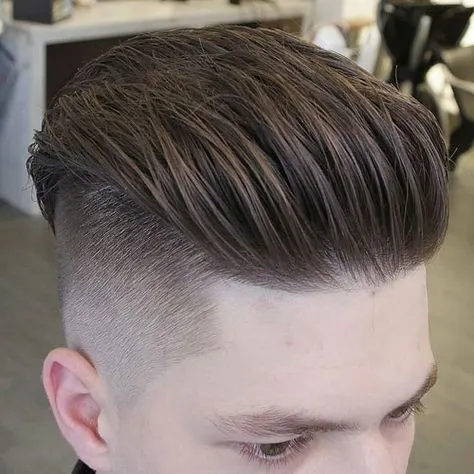
A straight hair undercut delivers the cleanest and sharpest contrast. Because straight strands naturally fall flat, the clipped sides make the top stand out even more.
Barbers usually use #0–#2 guards for the sides, leaving 3–6 inches on top. Straight hair can easily be styled into slick backs, pompadours, or side parts with the help of pomade or matte wax. Blow-drying adds extra lift.
Face Shapes
- Oval/Square: Perfect match — highlights natural angles.
- Round: Works if volume is styled high.
- Heart-shaped: Best with side part to balance forehead width.
This style fits well in corporate jobs, weddings, and formal events, because it always looks neat and polished.
A friend of mine got a straight hair undercut before his job interview. He texted later: “They asked me more about my hairstyle than my resume.” It gave him instant confidence.
If clean, sharp, and versatile are your style goals — could the straight hair undercut be your best investment?
Wavy Hair Undercut
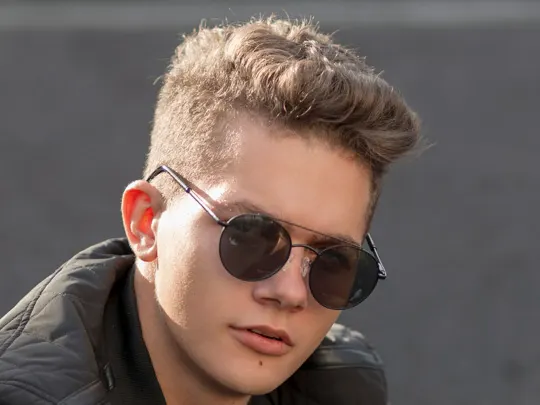
The wavy hair undercut strikes the balance between messy and refined. The buzzed sides highlight the natural texture, while the top’s waves create movement and volume.
Barbers trim sides with #0–#1 guard, leaving 4–7 inches on top. A sea salt spray or curl-enhancing cream defines the waves, while matte clay keeps them in place without stiffness. Blow-drying with a diffuser enhances bounce.
Face Shapes
- Oval: Effortlessly suits the shape.
- Round: Waves add vertical lift, making the face appear longer.
- Square: Textured flow softens sharp edges.
This cut thrives in creative industries, casual dates, and nightlife scenes. It has that effortless “I woke up like this” appeal, yet still looks styled.
At a beach wedding I attended, the groom styled his wavy undercut with a textured quiff. The sea breeze didn’t ruin it — instead, it made the waves look even better. Guests literally complimented his hair all night.
Who says waves only belong in the ocean when your hairstyle can carry them everywhere you go?
Curly Hair Undercut
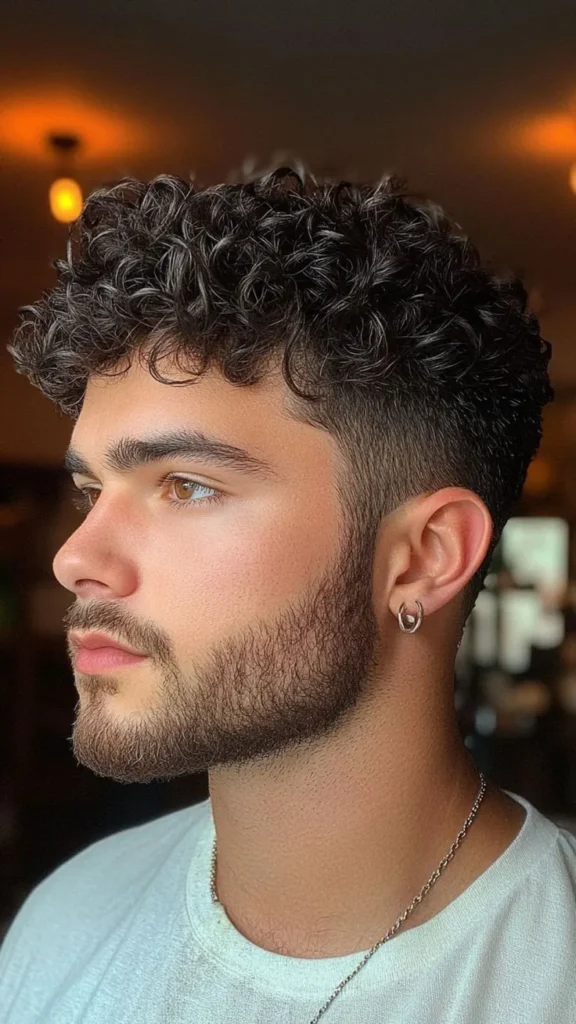
The curly hair undercut turns natural curls into the star of the show. With buzzed sides and volume on top, it frames the face while keeping curls manageable and stylish.
Barbers usually cut sides with a #0–#2 guard, leaving 5–8 inches on top. A curl cream, leave-in conditioner, or mousse helps control frizz and define shape. For extra hold, a light gel keeps curls intact without crunchiness.
Face Shapes
- Oval/Diamond: The curls balance symmetry.
- Round: Adds height, making the face appear longer.
- Square: Curls soften strong jawlines.
This look works in both casual and professional settings, especially when curls are shaped neatly. It’s versatile — playful for weekends, sharp for office wear.
I once styled a client with stubborn curls into an undercut fade. He came back two weeks later saying, “I’ve never had so many compliments on my hair — even my boss noticed.
If you’ve ever thought curls are hard to tame, could the undercut actually turn them into your greatest asset?
Afro Undercut

The Afro or locs undercut blends cultural heritage with modern edge. By shaving the sides and keeping the top natural, the undercut makes curls, coils, or dreadlocks stand out even more.
Barbers usually keep sides at #0–#1 guard, leaving the top long for Afros, twists, or locs. A moisturizing cream or shea butter keeps hair hydrated, while a sponge brush helps shape coils. Loc wearers often pair this with a mid or high fade for extra contrast.
Face Shapes
- Round: Taller Afros elongate the profile.
- Oval: Universally flattering.
- Square: Works best with medium-length locs that balance strong jawlines.
Seen in streetwear, hip-hop culture, and creative spaces, this undercut is bold yet deeply rooted in identity.
A barber I interviewed said one of his proudest cuts was giving a teen his first Afro undercut. The boy looked in the mirror and whispered, “I finally feel like myself.” That’s the power of style meeting culture.
Could this be the cut where heritage and modern style finally meet?
Asian Hair Undercut
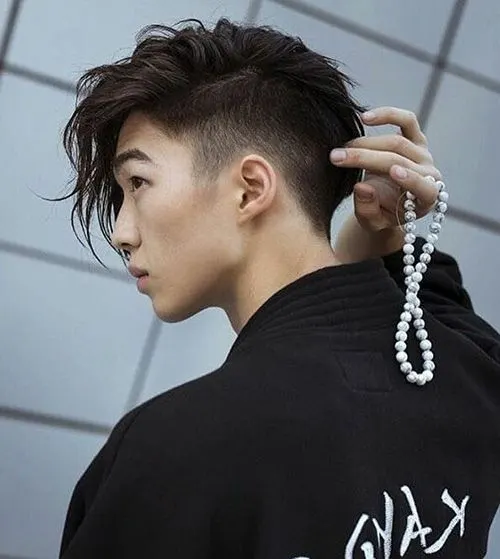
The Asian undercut has gained worldwide recognition, thanks to K-pop idols, anime-inspired looks, and fashion influencers. With naturally straight, thick hair, the style achieves a sleek and structured finish that holds its shape easily.
Barbers often use a #1–#2 guard on the sides with a sharp undercut or skin fade, while leaving the top medium length for curtains, textured quiff, or slick-back styles. Lightweight matte clay or sea salt spray works best to avoid heaviness.
Face Shapes
- Oval: Perfect match, enhances symmetry.
- Round: Side-parted Asian undercut slims the face.
- Square: Adds softness while keeping edges defined.
Popular in Seoul, Tokyo, and global street fashion, this look mixes boy-band charm with runway polish.
A college student once told me he copied his favorite idol’s Asian undercut. The very next day, classmates asked if he had a photoshoot lined up—proof that the style carries instant star quality.
Maybe that’s why the Asian undercut isn’t just a haircut—it’s a passport to looking effortlessly iconic.
Female Pixie Undercut
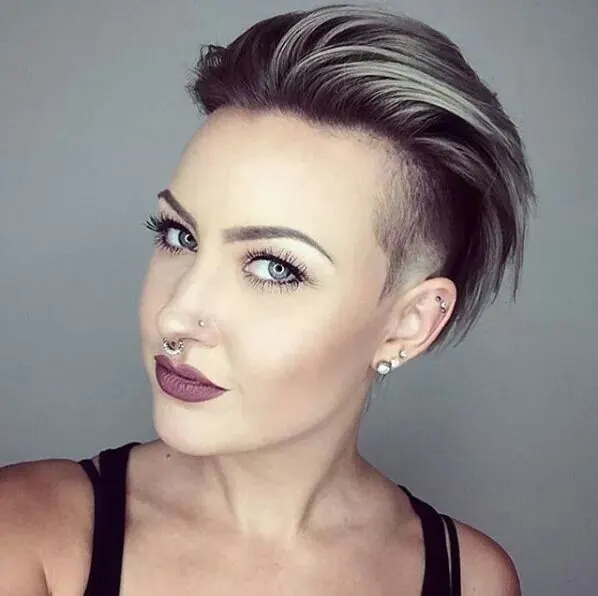
The female pixie undercut is a daring blend of femininity and rebellion. It combines the short, chic pixie cut with shaved or faded sides, giving women a bold yet elegant edge
Barbers usually shave sides with a #0–#1 guard, leaving the top 2–4 inches long. Styling wax or light-hold pomade keeps it playful, while texturizing sprays add volume.
Face Shapes
- Oval: Works beautifully, balancing softness with edge.
- Round: Adding height on top elongates the face.
- Square: Soft, wispy layers balance strong jawlines.
This undercut often appears in fashion magazines, art circles, and corporate settings where women want to stand out without losing sophistication.
A graphic designer I met said her pixie undercut was the “best icebreaker ever”—clients always complimented her hair, and it instantly made networking easier.
Could the pixie undercut be the most fearless way for women to merge confidence with style in 2025?
Hidden Undercut for Long Hair
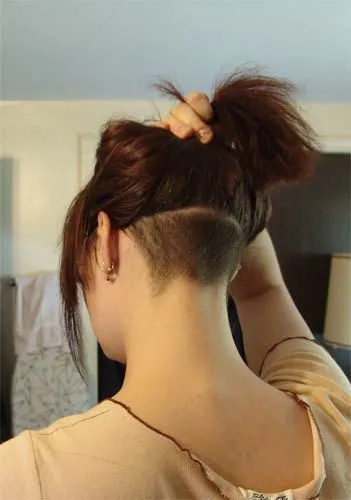
The hidden undercut is like a secret style statement—long, flowing hair on top with shaved sides or back that only show when you tie it up.
Barbers usually trim the nape or sides with a #0–#2 guard, leaving the rest of the hair untouched. It works best with layered cuts, since the shaved part blends naturally when hair is down.
Face Shapes
- Oval: Universally flattering.
- Round: Works if top layers are kept long and voluminous.
- Square: Side-swept styles soften the look.
Favored by professional women, students, and trendsetters, this undercut balances office-friendly looks by day and edgy vibes by night.
One of my friends had a hidden undercut during university. At presentations, her hair looked polished and formal—but at concerts, she tied it up, revealing the bold undercut that always drew compliments.
Isn’t it the perfect double life—professional on the surface, rebel underneath?
Undercut Bob
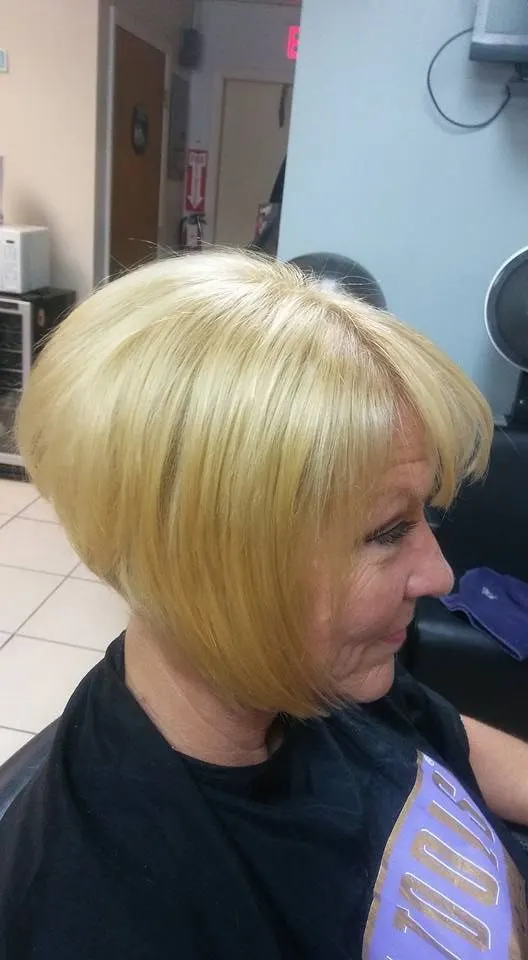
The undercut bob combines classic bob elegance with edgy shaved or tapered sides. The stacked variation adds volume at the back, giving a modern twist to a timeless style.
Barbers typically use #1–#2 guards for side undercuts, keeping the stacked back longer and layered. Styling with volumizing mousse or light texturizing cream helps maintain shape without stiffness.
Face Shapes
- Oval: Flattering with both sharp or soft edges.
- Round: Angled bob layers slim the face.
- Square: Stack adds softness to strong jawlines.
Ideal for office environments, parties, and casual outings, balancing sophistication and boldness effortlessly.
A colleague recently got a stacked undercut bob. On her first day back at work, she was complimented repeatedly, and she admitted it boosted her confidence instantly.
Could the undercut bob be the ultimate style hack—chic, bold, and effortlessly versatile?
Edgy Undercuts
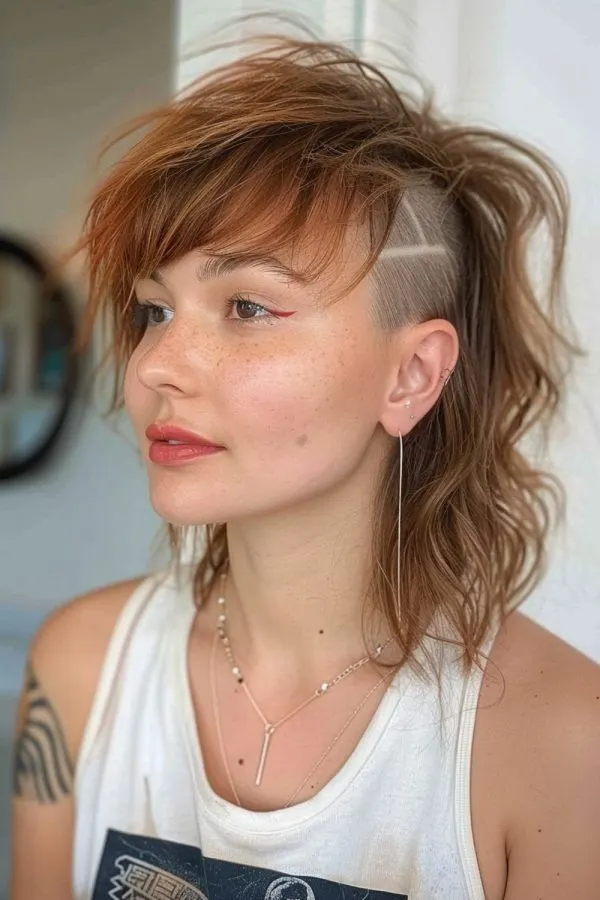
The feminine edgy undercut blends boldness with personality—shaved or patterned sides paired with creative top styles like asymmetrical cuts, curls, or vibrant colors.
Barbers usually use #0–#2 guards for side fades or patterns, leaving the top 4–8 inches for styling freedom. Products like texturizing clay, color-protecting creams, or lightweight mousse help maintain both style and vibrancy.
Face Shapes
- Oval: Perfect for experimenting with color or shape.
- Round: Longer top or side-swept layers balance proportions.
- Square: Soft waves or asymmetry reduce harsh angles.
Favored by artists, musicians, and fashion-forward professionals, this cut expresses personality while maintaining femininity.
A friend of mine dyed her edgy undercut lavender. Every time she walked into a room, people noticed first her hair — she said it felt like her style finally spoke before she did.
Ready to let your haircut reveal your boldest personality without saying a word?
Undercuts for Women Over 50
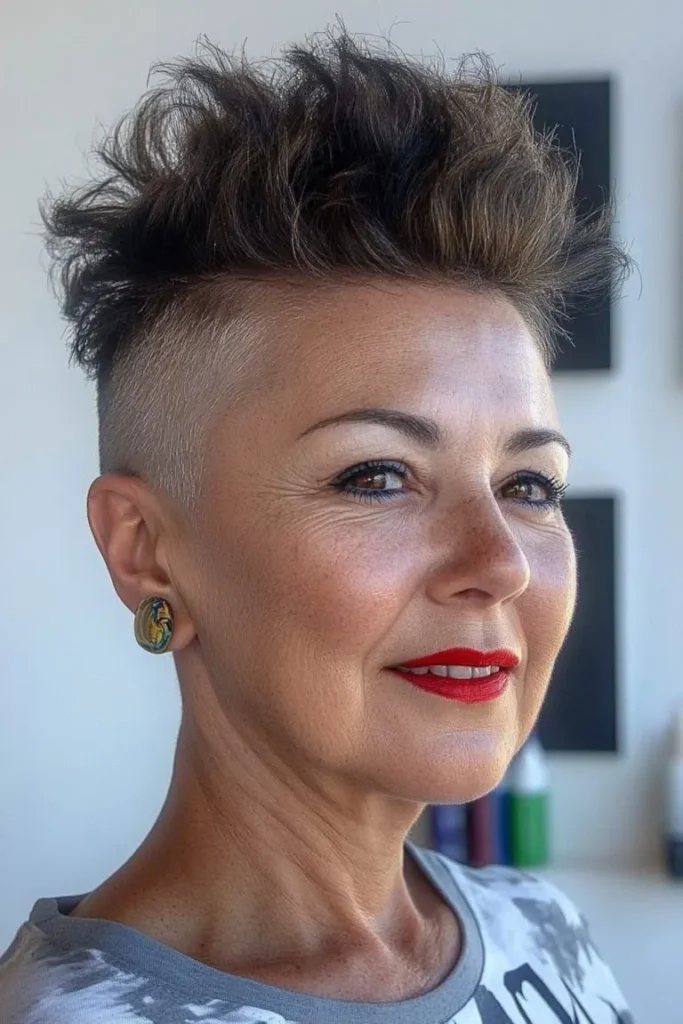
The over-50 undercut combines elegance and modernity. It keeps hair manageable while adding youthful structure, making it both stylish and age-appropriate.
Barbers typically use a #1–#2 guard on the sides, leaving the top medium length for layering or soft waves. Lightweight volumizing mousse or smoothing serum ensures easy daily styling without stiffness.
Face Shapes
- Oval: Universally flattering.
- Round: Longer top layers elongate the face.
- Square: Soft side layers soften jawlines.
Perfect for professional settings, social events, or casual daily wear, offering a polished yet contemporary look.
One of my clients, a 52-year-old executive, opted for an undercut. She mentioned, “I feel ten years younger and more confident walking into meetings.”
Could this be the style that proves chic undercuts have no age limit?
How to Style an Undercut at Home
Styling an undercut at home ensures you maintain its sharp, fresh look between barber visits. With the right techniques, even complex fades or long tops can look professional.
- Use blow-dryer with round brush for volume or smooth finish.
- Pomade, matte clay, or mousse depending on desired texture.
- For curly/wavy hair, diffuser attachment preserves natural curls.
- Regular trimming of top and sides every 3–6 weeks keeps contrast sharp.
Face Shapes
- Oval: Can experiment freely with height and texture.
- Round: Add vertical volume for balance.
- Square: Soft side styling reduces angular harshness.
Suitable for daily office wear, casual weekends, or night-outs. Flexibility allows quick changes from slick-back to messy or textured styles.
A client told me she styles her undercut in 10 minutes every morning, yet it always looks salon-fresh. She said, “It’s the easiest time I’ve ever spent on hair with the biggest impact.”
Could mastering home styling be the secret to keeping your undercut turning heads every day?
How to Style an Undercut at Home
Choosing the best products for undercut hairstyles ensures your cut maintains shape, texture, and shine—whether your hair is straight, wavy, curly, or coiled. Undercuts aren’t just for men; the right product works equally well for women and non-binary styles.
Micro Tip
- Pomade: Slick-back and shiny styles. Apply to slightly damp hair for even distribution.
- Matte Clay: Textured, casual looks without shine. Great for tousled or messy finishes.
- Volumizing Mousse: Adds lift for wavy or flat hair.
- Curl Cream / Leave-in Conditioner: Defines curls or locs and reduces frizz.
- Sea Salt Spray: Creates natural, effortless texture.
Face Shapes
- Oval: Works with any product or style.
- Round: Volumizing products add height and elongate the face.
- Square: Matte or soft-hold products soften angular jawlines.
From office to gym to nightlife, choosing the right undercut styling products lets you switch from polished to edgy effortlessly.
A barber once suggested lightweight clay over wax to a client with thick wavy hair. They said, “It finally holds my style without feeling sticky or heavy, and it works for my long top too.”
Could the right undercut styling product be the hidden secret that turns a standard haircut into a showstopper?
How Often to Get It Trimmed
Regular trims are essential to maintain the sharp contrast and clean lines of an undercut. Without upkeep, fades lose definition and long tops can look untamed.
- Short undercuts / skin fades: Every 2–3 weeks for crisp edges.
- Medium / longer tops: Every 4–6 weeks to maintain style and shape.
- Use sharp barber scissors or clippers to avoid uneven regrowth.
Face Shapes
- Oval: Flexible with trimming frequency.
- Round: Frequent trims keep volume balanced and face elongated.
- Square: Regular maintenance softens jawline harshness.
Perfect for busy professionals, students, or anyone wanting a polished look, as consistent trimming keeps the style sharp without daily struggle.
One client admitted, “I ignored trims for six weeks and my fade looked sloppy. After a quick visit, the barber restored it, and it felt like a confidence reboot.”
Could staying on top of trims be the easiest way to keep your undercut always turning heads?
How to Grow Out an Undercut Smoothly
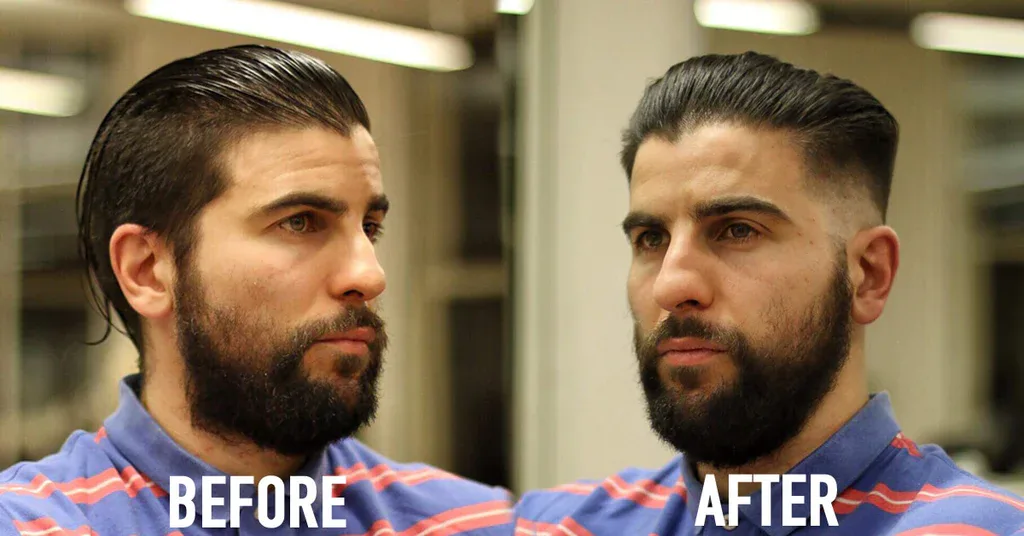
Growing out an undercut requires strategy to avoid awkward lengths and uneven layers. With careful styling, you can grow out an undercut without looking messy while transitioning to longer hairstyles, keeping a polished and intentional look.
Micro Tip
- Trim sides gradually every 6–8 weeks to blend growth—book trims for blending, not length, so you retain style as hair grows.
- Use styling products like lightweight mousse or smoothing serum to manage uneven lengths.
- Consider layering or texturizing the top for a balanced, professional finish.
- Optional: Use clip-in extensions or volumizing powders for temporary fullness during awkward phases.
- Contrast Line: Skip blending trims, and your grow-out quickly shifts from stylish to scruffy.
Face Shapes
- Oval: Can experiment freely with any growth style.
- Round: Keep volume on top to elongate the face.
- Square: Gradual side blending softens angular jawlines.
Perfect for professionals, creatives, or anyone wanting flexible hairstyles—growing out doesn’t mean compromising elegance.
A client grew out his undercut over 6 months. He said, “Following the gradual trim plan kept my hair looking intentional, not sloppy, and everyone noticed the difference at every stage.”
Could mastering the grow-out process turn what feels like an awkward stage into your boldest style statement yet?
What to Tell Your Barber for an Undercut
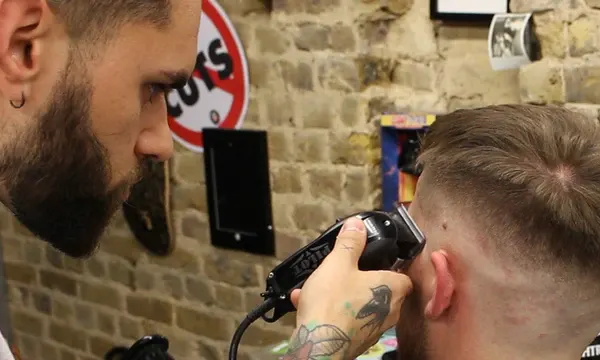
Communicating clearly with your barber ensures the undercut matches your face shape, hair texture, and personal style goals. Miscommunication can result in uneven fades or unintended lengths, turning what should be a confidence-boosting haircut into an awkward style.
Micro Tips
- Specify fade level (low, mid, high) and guard size (#0–#2)—this is key for how to ask your barber for an undercut correctly.
- Mention whether you want a disconnected look, tapered sides, or blended fade.
- Clarify top length, layering preferences, and any styling products you plan to use.
- Tip: Bring a photo if unsure—it saves a lot of explanation and ensures results match your vision.
- Contrast Line: Clear communication = confidence-boosting haircut vs guessing = awkward style.
Face Shapes
- Oval: Flexible—any undercut can work with minor adjustments.
- Round: Ask for more volume on top to elongate face.
- Square: Specify softer edges if you want to soften jawlines.
Useful before first-time cuts, seasonal trims, or major style changes. Clear instructions save time and prevent repeated visits.
A friend once said, “I just told my barber I wanted a subtle mid fade with 2-inch top layers, and it turned out perfect—no guesswork, no awkward surprises.”
Could the right conversation with your barber be the hidden trick to consistently flawless undercuts?
Choosing the Right Guard Size & Fade Level
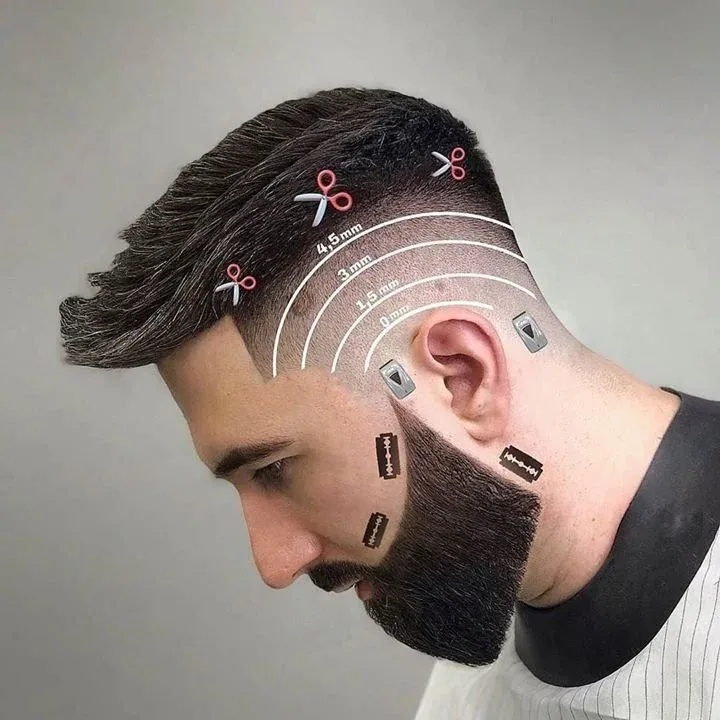
Selecting the correct guard size and fade level ensures your undercut complements your face shape, hair type, and desired style. Small adjustments dramatically change the final look.
Micro Tips
- Guard sizes: #0–#2 for tight fades; #3–#4 for longer, softer blends.
- Fade levels:
- Low fade: Subtle, starts near ear—great for professional settings.
- Mid fade: Balanced, versatile for casual and formal looks.
- High fade: Bold, edgy contrast—works well with disconnected or textured tops.
- Low fade: Subtle, starts near ear—great for professional settings.
- Tip: Ask your barber to show a sample fade line before cutting. It helps visualize contrast.
- Mention “undercut guard size guide” naturally if explaining to first-timers.
Face Shapes
- Oval: Can experiment with all fade levels.
- Round: Mid or high fades elongate the face.
- Square: Low fades soften angular jawlines; high fades add sharpness.
Choosing the right guard and fade keeps your undercut looking intentional, whether for office, casual outings, or nightlife.
A client once tried a #1 high fade without consultation. He admitted, “It looked too extreme for my oval face. After adjusting to #2 mid fade, it finally matched my style perfectly.”
Could mastering guard size and fade levels be the ultimate trick to getting your undercut exactly right every time?
Common Mistakes to Avoid
Avoiding common pitfalls ensures your undercut stays stylish, flattering, and low-maintenance. Even small errors can make a bold haircut look sloppy.
Micro Tips
- Skipping consultation: Always communicate desired fade, guard size, and top length.
- Over-length on sides: Can ruin the contrast; aim for precise blending.
- Ignoring hair texture: Curly, wavy, or straight hair behaves differently—style accordingly.
- Wrong products: Using heavy wax on fine hair flattens the look; choose lightweight clay or mousse.
- Neglecting trims: Gaps appear quickly; stick to recommended intervals.
- Tip: Always show a reference photo—visuals prevent misinterpretation.
Face Shapes
- Oval: Minor adjustments usually fix mistakes.
- Round: Avoid low-volume tops that emphasize roundness.
- Square: Too harsh fades can exaggerate angular jawlines.
Relevant for first-time undercuts, seasonal trims, or trying new fade levels. Preventing mistakes saves money, time, and frustration.
A client skipped telling his barber he wanted a mid fade. He said, “I got a low fade instead, and it looked completely off. Lesson learned—always bring a photo.”
Could avoiding these small mistakes be the difference between a haircut that turns heads and one that goes unnoticed?
How Long Does an Undercut Haircut Take?
Understanding the time commitment helps plan appointments and manage expectations. An undercut varies depending on fade complexity, top length, and styling details.
Technical Details
- Basic undercut with short fade: ~20–30 minutes.
- Disconnected or textured undercut: ~35–50 minutes.
- Longer top or intricate styling: up to 60 minutes.
- Tip: Factor in consultation time, especially for first-time cuts or complex fades.
Face Shapes
- Oval: Flexible—timing depends mainly on style complexity.
- Round/Square: Slightly longer if adding volume or softening edges.
Quick trims can fit lunch breaks or after-work sessions, while detailed styles may require weekend appointments.
A client said, “I booked 45 minutes for my textured quiff undercut, and the barber finished perfectly on time—worth every minute.”
Could understanding the timing upfront save you from rushed cuts or uneven results?
How Much Does an Undercut Cost in 2025?
Knowing the cost helps plan your budget and choose the right barber or salon for your undercut style, whether simple or intricate.
Micro Tips
- Basic undercut / low fade: $15–$30 (barbershop).
- Mid/high fade or disconnected styles: $30–$60.
- Luxury salon / celebrity barber: $70–$120+.
- Tip: Factor in additional styling products if your barber uses premium brands.
- Include “undercut haircut cost 2025” naturally in comparisons.
Cost may vary slightly depending on style complexity:
- Oval/Round/Square: No major difference, but detailed fades or textured tops can increase time and price.
- Perfect for professionals, students, and trend-followers who want a polished look without surprises.
A friend booked a high fade with textured top for $55. He said, “It felt worth every penny—the cut lasted weeks and turned heads everywhere.”
Could understanding 2025 pricing trends help you score the best undercut without overspending?
Is the Undercut Practical for Work & School?
Undercuts can be versatile, but practicality depends on profession, dress codes, and lifestyle. Choosing the right fade and top length ensures you remain stylish yet appropriate.
Micro Tips
- Professional settings: Opt for low or mid fades with moderate top length.
- Casual / creative fields: High fades or disconnected styles are usually acceptable.
- Students: Shorter fades reduce maintenance time; styling is quicker.
- Tip: Always check institutional or workplace grooming policies before trying bold variations.
Face Shapes & Styling Context
- Oval: Works for all environments.
- Round/Square: Slightly conservative fades are safer for formal settings.
- Styling can be quickly adapted with mousse or matte clay for different occasions.
A colleague chose a mid fade undercut for his office job. He shared, “It looks sharp, professional, but I can still style it edgy on weekends—best of both worlds.”
Could the right undercut strike the perfect balance between professional polish and personal style freedom?
Who Does It Suit Best?
Undercuts are versatile but best suited for certain face shapes, hair textures, and lifestyles to maximize style impact.
- Oval faces: Most undercut styles work; top length flexibility.
- Square faces: Sharp fades highlight strong jawlines.
- Round faces: Keep volume on top to elongate the face.
- Hair texture: Straight and wavy hair adapt easily; curly hair may require layering; Afro/locs need extra maintenance.
Ideal for professionals, creatives, trendsetters, and anyone wanting a bold, modern look without daily hassle.
A friend with a round face added volume on top with a mid fade. He said, “It completely transformed my profile—photos finally looked sharp.”
Could knowing your face shape unlock the undercut that truly enhances your features?
Advantages of the Style
The undercut offers a blend of style, versatility, and low-to-moderate maintenance, making it a favorite among fashion-forward individuals.
Micro Tips
- Versatility: Works with pompadours, slick backs, quiffs, or messy textures.
- Maintenance: Short sides reduce daily upkeep; only the top requires styling.
- Styling options: Can switch between professional and edgy looks with minimal effort.
- Trend relevance: Remains popular in 2025, worn by athletes, actors, and influencers.
- Micro Tip: Use matte clay or volumizing mousse for different effects.
Face Shapes
- Enhances angular features and balances round faces.
- Perfect for office, casual outings, parties, or special events.
A client said, “I can go straight to work with a neat fade and then just add some mousse for a night out—it’s effortless.”
Could this mix of style, flexibility, and low maintenance be why the undercut remains a top choice in 2025?
Drawbacks & High-Maintenance Aspects
While stylish, undercuts can demand regular upkeep and specific styling, which may not suit everyone’s routine or lifestyle.
Micro Tips
- Frequent trims: Sides grow quickly; maintain every 3–4 weeks for sharp fades.
- Styling required: Top hair may need daily product application for volume or texture.
- Hair type challenges: Curly or coarse hair may require additional styling or anti-frizz products.
- Micro Tip: Schedule trims based on fade type, not just length—prevents scruffy transitions.
Face Shapes
- Round faces: Extra volume maintenance needed.
- Square faces: Sharp fades require consistent upkeep.
- Best suited for those who enjoy grooming and experimenting with products.
A friend admitted, “I skipped trims for two months, and my high fade turned into a messy blur—lesson learned!”
Could understanding the upkeep beforehand save you from regret and keep your undercut looking crisp?
What Is Undercut in Welding?
In welding, an undercut is a groove that forms at the edge of a weld, weakening the joint if not managed properly.
Micro Tips
- Avoid excessive heat or improper angle to prevent undercuts.
- Inspect each weld visually; minor undercuts may be corrected with filler material.
- Tip: Use proper electrode technique to maintain uniform weld depth.
Common in structural welding, shipbuilding, and automotive fabrication.
A welding apprentice once ignored a tiny undercut; the supervisor corrected it, saying, “Small grooves today can be cracks tomorrow.”
Could mastering undercuts in welding be as crucial as mastering undercuts in hairstyles?
What Is Undercut in Formula 1?
In F1 racing, an undercut refers to pitting earlier than competitors to gain track position via fresher tires.
Micro Tips
- Teams monitor lap times and tire degradation closely.
- Early pit stop can help overtake rivals during their later stops.
- Tip: Timing is everything—too early may waste tire potential.
Used strategically in high-speed circuits where tire performance is critical.
During the 2023 Monaco GP, a driver’s early undercut gained two positions, proving the tactic’s power.
Could the concept of “undercut” in racing inspire a similar edge in your hairstyle choices—timing and strategy matter?
FAQs About the Undercut Hairstyle
What is an undercut haircut?
An undercut haircut features short or shaved sides with longer hair on top, creating contrast. It’s versatile and suits various face shapes.
- Tip: Ask your barber for desired fade level and top length.
- Anecdote: A client said, “Once I tried a disconnected undercut, I realized it completely changed my look!”
Should I get an undercut?
If you want a bold, modern style and are willing to maintain trims, an undercut can suit almost anyone.
- Face shapes: Oval and square faces adapt easily; round faces may need extra top volume.
- Tip: Consider your lifestyle and styling commitment before deciding.
How to style an undercut for men vs women?
- Men: Pompadour, quiff, slick back, messy textured styles.
- Women: Pixie undercut, hidden side undercut, stacked bob.
- Tip: Use lightweight mousse or clay to control volume and texture.
Is an undercut still in fashion in 2025?
Yes! Celebrities and athletes continue to showcase high fades, disconnected undercuts, and textured quiffs worldwide. Trend reports show consistent popularity growth.
How long does it take to grow out an undercut?
Typically 3–6 months for sides to blend naturally with the top.
- Tip: Regular trims at the top maintain style while sides catch up.
What is the best undercut for curly hair?
A tapered or mid fade undercut works best; layering the top reduces bulk and keeps curls manageable.
- Tip: Use curl-enhancing cream and diffuse-dry for definition.
Could answering these FAQs save you from common undercut mistakes and get the exact style you want?


